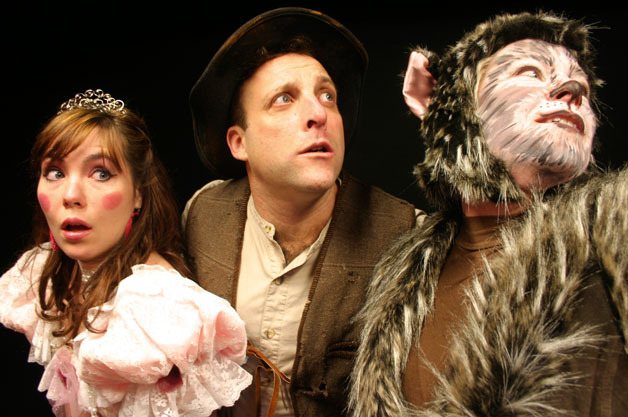Picture the funniest American musical comedy onstage, with vaudeville routines thrown in for good measure.
Add to that audience members booing and hissing the bad guys.
That’s what British pantomime is all about and, as the Brits have known for centuries, it’s a whole lot of family fun. That’s why it remains a Christmas tradition throughout the British Isles and elsewhere around the world.
Whidbey Children’s Theater presents its own English traditional holiday treat with “Puss in Boots,” a pantomime adapted by Damian Trasler, David Lovesy and Steve Clark, with special arrangement by Lazy Bee Scripts.
Directed by Suzanne Kelman (English born and bred) and Susannah Rose Woods, “Puss in Boots,” opens Thursday, Dec. 9 and plays through Sunday, Dec. 12.
Kelman said pantomimes are as common as turkey and plum pudding in England.
“We grew up with them,” she said. “Everybody went to see a panto at Christmastime. Even the teachers did them at school.”
As early as the 19th century, the “panto” developed as Christmas entertainment in England as comic relief between the acts at the opera. As their popularity grew, pantomimes gradually became more topical and comical, and often involved elaborate special theatrical effects.
“They are always tongue-in-cheek,” Kelman said. “And they usually make fun of locals, like the headmaster of the school or something.”
Kelman, a professional actor for most of her life, had done four pantomimes onstage as a girl at the well-known Alexandra Theatre in Birmingham, England. She worked with big celebrities from England and America in the pantos, which is a tradition of the form.
The famous Drury Lane Theatre in London was one of the first to stage real pantomimes, which had their own particular set of conventions and were considered a sort of “low opera.” The typical players in a panto include the older dame role, usually the mother of the hero, and often played by a man in drag; the principal boy played by a young woman; the animal-costume roles; and plenty of boisterous audience participation.
Still traditionally performed today at Christmas for family audiences, British pantomime is now a popular form of theater, incorporating song, dance, buffoonery, slapstick, cross-dressing, in-jokes, topical references, audience participation and mild sexual innuendo purposefully written to go over the heads of children in the audience. The audience is encouraged to “boo” the villain and “awww” the victim with gusto.
British children grow up with going to a pantomime during the holidays.
“We would go every year,” Kelman said. “Mum would go do the Christmas shopping, while dad takes the kids to the panto. That’s what a lot of families did.”
Last year, she brought her son Christopher to his first pantomime in London. And since pantomimes are about 50 percent audience participation, Kelman knew enough to be ready for anything. She and her son and her 95-year-old grandmother got sprayed with water at one point, which Kelman was ready for. Christopher got wet. She said her grandmother should have known better, since she had been to pantos all her life.
Pantos are almost always based on children’s stories and fairy tales, though plot lines of the familiar stories are often manipulated for comic effect. The story is not really the point.
“When children are brought to the theater, they’re usually told to be quiet,” Kelman said. “The pantomime allows them to be loud and boisterous. The English know that when a ghost comes onto the stage you’re supposed to shout, ‘Look out! There’s a ghost behind you!’ We want the audience to boo and hiss at the villain and cheer when the fairy comes on. It makes it better for the actors so they can play off it. The story is not important at all. It’s all fun and slapstick,” she added.
Kelman and Woods are happy to introduce an American audience to the form. For Kelman, it’s something that is close to her heart and an extension of her roots. Woods said she feels lucky to share the experience of directing such a fun show with Kelman.
“Directing is usually a solitary endeavor,” Woods said. “But it’s an absolute joy to be doing all this stuff together with Suzanne. It gives me an incredible sense of camaraderie. I look forward to coming to rehearsals every day.”
The most popular pantomime is “Cinderella,” which was first shown at that other bastion of London theater, Covent Garden, in 1870. Other popular pantos include “Aladdin,” “Goldilocks and the Three Bears,” “Jack and the Beanstalk,” “Little Red Riding Hood,” “Mother Goose,” “Peter Pan,” “Robinson Crusoe,” “Sleeping Beauty,” “Snow White,” “The Princess and the Pea,” “The Snow Queen” and, of course, “Puss in Boots.”
Kelman said the pantomime serves a larger purpose in the end, as she sees it.
“In these times, when everything is dark and times are hard, we can all look forward to just laughing,” she said. “Just come here and laugh.”
The Whidbey Children’s Theater “Puss in Boots” pantomime stars the motley band of Sam Cass, Bristol Bloom, Michelle Durr, Valerie Huntington, Kent Junge, Suzanne Kelman, Adam Schults, Jimmy Scullin, Erick Westphal, Robert Marsanyi, Melinda Mack, Ryan Georgi, Mike Thompson, Sarafina Durr, Debby Elwell and Hannah Mack.
“Puss in Boots” plays at 7:30 at Whidbey Children’s Theater Dec. 9-11, and at 2 and 7:30 p.m. Sunday, Dec. 12. Tickets are $12 for adults and $8 for students and seniors.
Family night is $7 for all seats on Thursday, Dec. 9.
Visit wwwWCTonline.com for more info or call 221-2282 for tickets.


